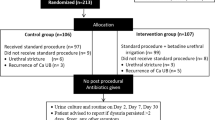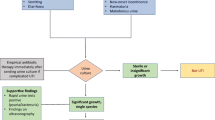Abstract
Objective
An uncontaminated urine culture is a prerequisite for the diagnosis of a urinary tract infection. However, this may be difficult to obtain in small children. We have studied the frequency of ballooning of the prepuce in non-circumcised boys and vaginal reflux in girls during voiding as a possible cause of contaminated urine cultures.
Methods
All micturating cystourethrograms (MCUG) performed in our institution over the last 5 years in children aged 0–15 years were reviewed retrospectively for ballooning of the foreskin or vaginal reflux as a potential source of bacterial contamination. The voiding pictures were routinely done with the catheter present for the first voiding cycle and then removed on the second void.
Results
A total of 526 children (77.4 % boys, 22.6 % girls) were eligible for the study. Ballooning of the foreskin was identified on the micturition pictures of 115 (38 %) boys, with the frequency significantly higher in boys aged <12 months [odds ratio (OR) 4.1; 95 % confidence interval (CI) 2.1–7.3)] and boys with vesicoureteral reflux (OR 1.6; 95 % CI 1.06–2.4). Seventeen girls (14.3 %) showed vaginal reflux. No correlation with age or vesicoureteral reflux was found in the girls.
Conclusion
Ballooning of the prepuce or vaginal reflux was seen on a fluoroscopic MCUG in a large proportion of children during their voiding. This normal phenomenon might cause contaminated urine cultures when the urine is obtained by bag or clean catch.


Similar content being viewed by others
References
Al-Orifi F, McGillivray D, Tange S, Kramer MS (2000) Urine culture from bag specimens in young children: are the risks too high? J Pediatr 137:221–226
Mori R, Lakhanpaul M, Verrier-Jones K (2007) Diagnosis and management of urinary tract infection in children: summary of NICE guidance. BMJ 335:395–397
Roberts KB (2011) Urinary tract infection: clinical practice guideline for the diagnosis and management of the initial UTI in febrile infants and children 2 to 24 months. Pediatrics 128:595–610
Babu R, Harrison SK, Hutton KA (2004) Ballooning of the foreskin and physiological phimosis: is there any objective evidence of obstructed voiding? BJU Int 94:384–387
Griffiths D, Frank JD (1992) Inappropriate circumcision referrals by GPs. J R Soc Med 85:324–325
Wright JE (1994) Further to “the further fate of the foreskin”. Update on the natural history of the foreskin. Med J Aust 160:134–135
Tosif S, Baker A, Oakley E, Donath S, Babl FE (2012) Contamination rates of different urine collection methods for the diagnosis of urinary tract infections in young children: an observational cohort study. J Paediatr Child Health 48:659–664
Karacan C, Erkek N, Senel S, Akin GS, Catli G, Tavil B (2010) Evaluation of urine collection methods for the diagnosis of urinary tract infection in children. Med Princ Pract 19:188–191
Schlager TA, Hendley JO, Dudley SM, Hayden GF (1995) Lohr JA (1995) Explanation for false-positive urine cultures obtained by bag technique. Arch Pediatr Adolesc Med 149:170–173
Bollgren I (1976) Winberg J (1976) The periurethral aerobic bacterial flora in healthy boys and girls. Acta Paediatr Scand 65:74–80
Oster J (1968) Further fate of the foreskin. Incidence of preputial adhesions, phimosis, and smegma among Danish schoolboys. Arch Dis Child 43:200–203
Kayaba H, Tamura H, Kitajima S, Fujiwara Y, Kato T, Kato T (1996) Analysis of shape and retractability of the prepuce in 603 Japanese boys. J Urol 156:1813–1815
Wiswell TE, Miller GM, Gelston HM Jr, Jones SK, Clemmings AF (1988) Effect of circumcision status on periurethral bacterial flora during the first year of life. J Pediatr 113:442–446
Agartan CA, Kaya DA, Ozturk CE, Gulcan A (2005) Is aerobic preputial flora age dependent? Jpn J Infect Dis 58:276–278
Wijesinha SS, Atkins BL, Dudley NE, Tam PK (1988) Does circumcision alter the periurethral bacterial flora? Pediatr Surg Int 13:146–148
Mattsson S, Gladh G (2003) Urethrovaginal reflux—a common cause of daytime incontinence in girls. Pediatrics 111:136–139
Bernasconi M, Borsari A, Garzoni L, Siegenthaler G, Bianchetti MG, Rizzi M (2009) Vaginal voiding: a common cause of daytime urinary leakage in girls. J Pediatr Adolesc Gynecol 22:347–350
Hammerschlag MR, Alpert S, Rosner I, Thurston P, Semine D, McComb D (1978) McCormack WM (1978) Microbiology of the vagina in children: normal and potentially pathogenic organisms. Pediatrics 62:57–62
Gerstner GJ, Grunberger W, Boschitsch E, Rotter M (1982) Vaginal organisms in prepubertal children with and without vulvovaginitis. A vaginoscopic study. Arch Gynecol 231:247–252
Marin JR, Shaikh N, Docimo SG, Hickey RW, Hoberman A (2014) Videos in clinical medicine. Suprapubic bladder aspiration. N Engl J Med 371:e13
Contributors’ statement
Nakysa Hooman conceptualised and designed the study, carried out the initial analyses, drafted the initial manuscript and approved the final manuscript as submitted. Marina Easty designed the data collection, reviewed and revised the manuscript and approved the final manuscript as submitted. Kjell Tullus conceptualised and designed the study, coordinated and supervised data collection, critically reviewed the manuscript and approved the final manuscript as submitted.
All authors approved the final manuscript as submitted and agree to be accountable for all aspects of the work.
Author information
Authors and Affiliations
Corresponding author
Ethics declarations
Funding Source
None.
Financial Disclosure
None.
Conflict of interests
None.
Rights and permissions
About this article
Cite this article
Tullus, K., Hooman, N. & Easty, M. Flushing of the vagina and the prepuce—a cause for contaminated urine cultures in children. Pediatr Nephrol 32, 107–111 (2017). https://doi.org/10.1007/s00467-016-3463-9
Received:
Revised:
Accepted:
Published:
Issue Date:
DOI: https://doi.org/10.1007/s00467-016-3463-9




